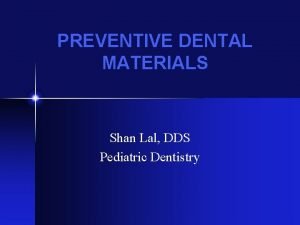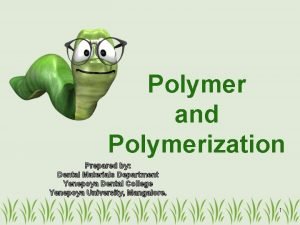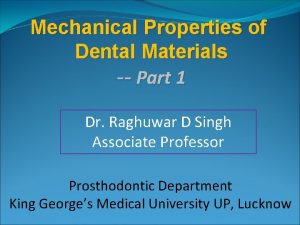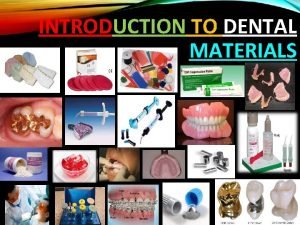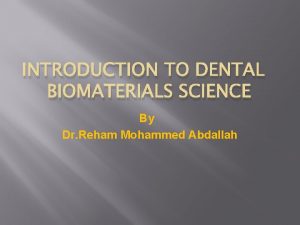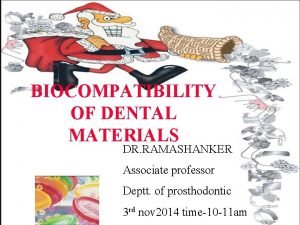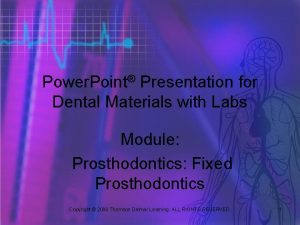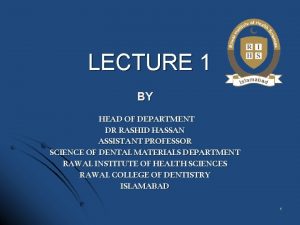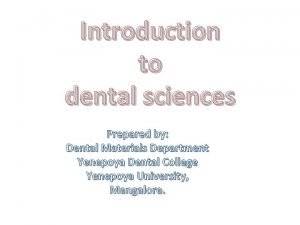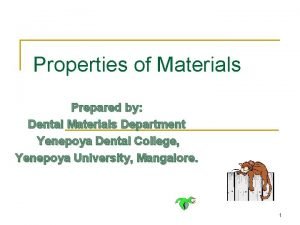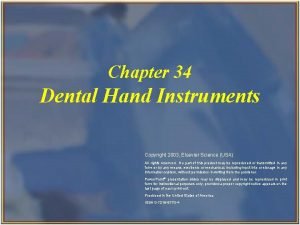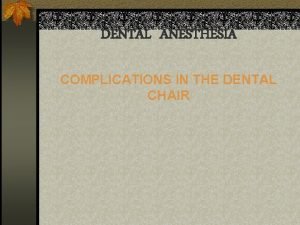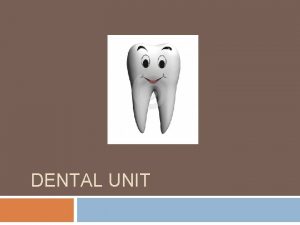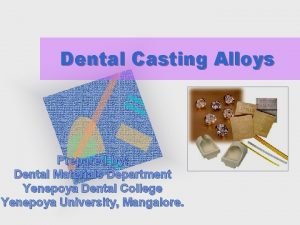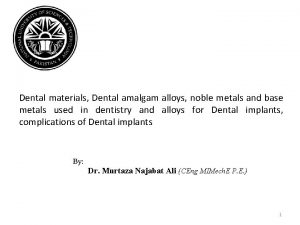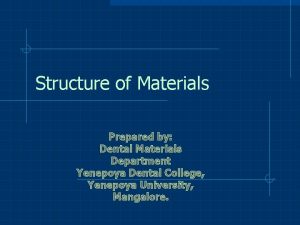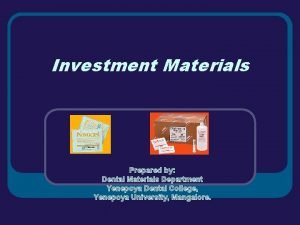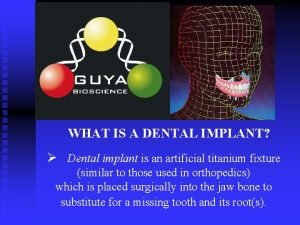Conclusion of first part of dental materials Conclusion




















- Slides: 20

Conclusion of first part of dental materials

Conclusion 1/ Why is better to use dental alloys than pure metals? - the composition of individual chemical elements or metal in alloy are so, that the properties of whole alloy are the best 2/ When was began to use dental alloys? -the development of metal alloys arrived at the ending of 19. Century, when Mr. Bing constructed the first inlay°s bridge 3/ What is the main criterium for distribution of dental alloys? -the main criterium for this distribution and for assigning of ISO standard is hardness of material - the hardness of dental material can characterised by the Vickers and by the Brinell

Conclusion 4/ Write the distribution of dental alloys – according to standard ISO (hardness material) - The alloys with the high content of aurum and platinum ( ISO 1562) - The alloys with flat content of aurum and platinum, they are the alloys of argentum and palladium ( ISO 8891) - The alloys of general metals ( cobalt, nickel ) ( ISO 6871) - The alloys for ceramic burning ( titanium too) ( ISO 9693) - The alloys as a aluminium bronze

Conclusion 5/ Characterise the properties of gold-platinum, ISO ( ISO 1562). -they are indicated for large bridges - they contetnt of aurum 75 -90 %, 8 -19% pllatinum, 4 -10 % palladium, iron, iridium -iridium easy oxidate and make adhesion to the ceramic - palladium has a high temperature of melting, higher mechanical resistence and lower price - disadvantage is that palladium discolors the yelllow color of aurum -typical color of these alloys after oxidation is grey or brown-grey

Conclusion 6/ Write the main characteristic of general metal alloys - the basic of these alloys is cobalt or nickel - next they include chrom (min 20 -25 %), molybdenum (4%), iron, mangan, wolfram, berilium, titanium, carbon, nitrogen, silicium - the content of nickel or cobalt, must be minimally 85% - chrom very increased the hardness of material - these alloys are indicate for metal construction of removable partial denture, large bridges, metaloceramic construction - very heavy disadvantage is volumetric contraction by the freezing

Conclusion 7/ What is the galvanism? - it is a complex of processes, which are result from elektrochemical reactions - in general, it is rise of electric tension between two electrodes, which are coupled with fluid -the basic of galvanism is ability of metals to release the cations from surface of metal alloy 8/ How can you characterise the stomatitis galvanica? -they are clinical manifestation of galvanic stimulus on the mucosa surface - to the symptoms belong : parestesia, stripes, disorders smack, strog attack of pain neuralgiform character - it is glossitis or stomatitis

Conclusion 9/ Describe the chemical chracteristic of cobalt-chrom alloys. -after standard ISO, cobalt alloys have to contain at least 25% Cr, 4% Mo -reorganisation of atoms into the atomic lattice are the cause of volume expansion - the casting temperature of cobalt alloys is 1400°C 10/ Explain the mechanical properties of cobalt alloys. - the Co-Cr dental alloys are very strong and hard, because size of atoms of Co, Cr and Mo is similar (Co 0, 25; Cr 0, 26; Mo 0, 28 mikrometra) - atomic lattice is very resistant to the external forces

Conclusion 11/ What is the cause of resistance before corrosion. - protection before corrosion is passive layer, which create by the chrome - the cobalt alloys are more resistant before corrosion than nickel alloys, because the cobalt alloy dont make easy free cations 12/ Why the nickel alloys support hypersensitievity? metal cations react with anions surrounding medium. So they can make macromolekules. These elementary parts from alloys are trasported to the various parts of body. - solubile compound of Ni-alloys are absorbed very quick and ca make change in structure of DNA and so support damage

Conclusion 13/ Describe the main characteristic of solders for Ni-Cr alloys. - the solder must have the melting temperature about 100°C decreased than is the melting temperature of origin alloy ( for protect of origin alloy) - a chemical composition of solder is similar as a composition of origin alloy - from it results, that the place of connection is not very different from whole cast - the different composition solder and origin alloy produces the base for galvanic current

Conclusion 14/ How can you describe the fineness of gold alloys? - it is the proportion of gold in gold alloys. - into the fineness belong the rate of platinum too - the main measurement of fineness is thousandth or carats - we distiguish 5 gradus of fineness 15/ Explain the chemical properties of gold alloys. - they are without change on air and in water - they are resistant before oxidation, it means they are resistant before corrosion - they do not react with all of acids ( as a concentrate or as a solutions) - only one solution , which can dissolve gold alloys, is solution of nitric acid and hydrochloric acid in volumetric rate is 1: 3

Conclusion 16/ Write the distribution of gold alloys according to hardness of material. - It is distribution at four classes ( type 1 – 4) -Type 1 is smooth alloys with high content of gold; type 4 is very strong alloys with high content of pllatinum and palladium 17/ How can be changed the physical properties in gold alloys, when is added palladium and pllatinum? - palladium and pllatinum provide higher casting temperature, higher mechanical resistance and narrower price - their disadventages is decoloration from yellow on white color -typical color of these alloys after oxidation is grey or grey-brown

Conclusion 18/ Describe the general properties of titanium. - titanium is very good biocompatible material - it has a exeptional resistance before corrosion - it can be use as a bioactive material, which can make adhesion with vital tissue - It is one metal, which is in nature as binary alloys and in dental prax is used as a pure metal 19/ When began the indutrial production of titanium? - at 1932 y. – as a chemical reaction between Ti. O 2 and calcium or magnesium - it was in America, Japan and in Russia

Conclusion 20/ Characterise the physical properties of titanium. -titanium is the metal of steel color with high brightness - difference from steel is in the weight. It is result from unequal density - the density of pure titanium is about 4, 51 g/cm 3 , and Ti – alloys is 4, 40 – 4, 80 g/cm 3. - in equation with cobalt alloys, which have density about 8, 2 g/cm 3 , the weight of the metal titanium cast is less about 43% than weight of similar cobalt cast ( according to large and shape)

Conclusion 21/ What is the main principle of melting titanium ? - the melting of titanium is by the mercury arc in vacuum - this metod names as a „skull melting“ - other type of melting titanium is during the induction current - this melting is running in the vacuum with special inert gas, argon (colorless and odorless gas) 22/ Explain the soldering of titanium. - soldering of titanium parts is by the welding - according to very strong chemical reaction of titanium by the temperature above than 500°C, must be soldering very quick and with high thermal energy, by laser ray

Conclusion 23/ Which type of plaster is the main type for using in dental practice, for making others type of plaster. - It is plaster of Paris 24/ What is the chemical base of plaster of paris? - it is anhydric beta polyhydrate of gypsum: Ca. SO 4. 1/2 H 2 O - it is produced by the process of dehydration of gypsum - chemical reaction is following Ca. SO 4. 2 H 2 O Ca. SO 4. 1/2 H 2 O + 1/2 H 2 O

Conclusion 25/ Write the dividing of dental plaster according to chemical properties: from chemical view can be divided : 1. plaster of Paris ( soft plaster) 2. hydrocal plaster ( hard plaster) 3. densite plaster ( super hard plaster) 26/ Characterise the hydrocal plaster - the base of this plaster is the alfa polyhydrate plaster of paris - this plaster is more hardness than plaster of paris - chemical and physical properties of both type are similar, but atomic lattice is different - the beta plaster has a high porosity, but hydrocal plaster has nonporosity crystals

Conclusion 27/ Explain the setting of plaster. - Setting is exotermic reaction, it is hydration: Ca. SO 4. 1/2 H 2 O + 1, 5 H 2 O Ca. SO 4. 2 H 2 O + heat - by the setting is mixed the powder with water - by the setting create the volume expansion - the condition of this expansion is mashing of rising crystals - the name of this expansion is hydroscopic expansion 28/ How can be accelerated the setting of plaster? - accelerating of setting can be secured with the : - hot water - chemical regulators of setting - change of mixing speed (intensive mixing) - changen of mixing rate

Conclusion 29/ Why is important the hydroscopic expansion at the setting of plaster? - it is necessary for compensation of contraction of metal alloys at the cooling 30/ What is the base for determination of plaster hardneess? -the hardness is depend on character , large and shape of atomic crystals - the plaster of paris is adorned with a crystals in shape of needles , this atomic lattice need for mixing a lot of water and from physical properties it is soft type of plaster - superhard plaster is squars as a shape of atomic lattice and for mixing need a very little volume of water

Conclusion 31/ Explain the mixing rate W/P (water/powder). it is volume of water to content of powder, which is necessary for making slurry plaster matter, for making prosthetic models 32/ Which type of plaster is the best for dental use and why? - it is superhard plaster, type IV - mixing rate is V/P 18, 5 -24 - hardness is 60 MPa - volume expapnsion at the setting is 0, 1% -according to high hardness and mechanical resistance it is a good type for working models at fixed bridge and crown

End.
 Preventive dental materials
Preventive dental materials Polymerization in dentistry
Polymerization in dentistry Ideal properties of dental materials
Ideal properties of dental materials Stress strain curve toughness
Stress strain curve toughness Auxiliary dental materials
Auxiliary dental materials Auxiliary dental materials
Auxiliary dental materials Most biocompatible dental materials
Most biocompatible dental materials Impression materials in dentistry ppt
Impression materials in dentistry ppt Auxiliary dental materials
Auxiliary dental materials Introduction to dental materials
Introduction to dental materials Dental materials
Dental materials Cant stop the feeling trolls go noodle
Cant stop the feeling trolls go noodle Meaning of useful and harmful materials
Meaning of useful and harmful materials Natural man made
Natural man made Adopting materials
Adopting materials Direct materials budget with multiple materials
Direct materials budget with multiple materials Dental implant tray setup
Dental implant tray setup Part of a dental instrument that the operator grasps.
Part of a dental instrument that the operator grasps. Texas health steps quick reference guide
Texas health steps quick reference guide Addition symbol
Addition symbol Unit ratio definition
Unit ratio definition
